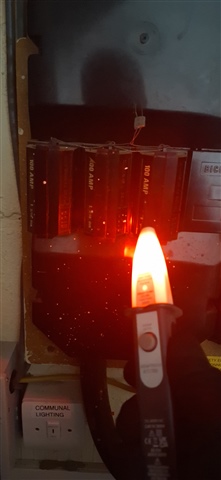i have come across black cut out fuses that light up my single pole tester, but only on the label.
my 2 pole tester does not light up from label to MET.
is this my single pole tester being over sensitive or should i call 105?
i have come across black cut out fuses that light up my single pole tester, but only on the label.
my 2 pole tester does not light up from label to MET.
is this my single pole tester being over sensitive or should i call 105?
Is that a non-contact sensor? I.e. would you expect it to light stroking the jacket of a dry PVC single insulated wire with a copper core that was live ? If so there is probably nothing to worry about - there is always some electric field around live parts and a cut out is a place where the spacing between the live parts and the associated neutral/earth is wider than normal, so the volume where that field will be detectable is larger. However, if the probe is one that normally only lights when you actually connect its tip to a live part, then assuming its not dripping wet, you may be looking at plastic that is starting to lose its insulating properties. Even so degrading insulation not really dangerous until a thumbprint size contact picks up a good fraction of a mA. (*)
The fact the other sensor shows no response suggests if there is any unusual leakage developing at all, it's not yet at a significant level.
Mike.
* and at that point, avoid touching it with your thumb or finger tips while other bits of you are solidly earthed - you may only feel a tingle, or maybe worse ... ;-)
Is that a non-contact sensor? I.e. would you expect it to light stroking the jacket of a dry PVC single insulated wire with a copper core that was live ? If so there is probably nothing to worry about - there is always some electric field around live parts and a cut out is a place where the spacing between the live parts and the associated neutral/earth is wider than normal, so the volume where that field will be detectable is larger. However, if the probe is one that normally only lights when you actually connect its tip to a live part, then assuming its not dripping wet, you may be looking at plastic that is starting to lose its insulating properties. Even so degrading insulation not really dangerous until a thumbprint size contact picks up a good fraction of a mA. (*)
The fact the other sensor shows no response suggests if there is any unusual leakage developing at all, it's not yet at a significant level.
Mike.
* and at that point, avoid touching it with your thumb or finger tips while other bits of you are solidly earthed - you may only feel a tingle, or maybe worse ... ;-)
We're about to take you to the IET registration website. Don't worry though, you'll be sent straight back to the community after completing the registration.
Continue to the IET registration site